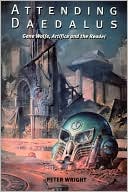Alzabo's kiss. (2)

Attending Daedalus: Gene Wolfe, Artifice, & the Reader by Peter Wright.
Synthetic angels
transubstantiate into
the genuine thing.
Right out of the gate let me deal with this. Peter Wright has a lot of smart things to say about The Book of the New Sun. His nuts & bolts are fine, great even. Everything here may be couched in academic tone, but I expect that from literary criticism published by a university press. The problem here is his thesis. I feel like Peter Wright, by acknowledging Severian's treatment of quadruplex allegory (triune, in Severian's version, since why not Judeo-Christian it a little), tries to wriggle out from admitting that it sort of ruins his entire interpretation (65). Severian tells Dorcas about the literal, the metaphorical, & the transubstantial meaning, but Wright sticks with the second one. Spoilers for those of you who haven't read it: Peter Wright insists that since the hierodules are admittedly creations of human(ish)kind, the transroboalienposthuman offspring who attempt to shape humanity in the past/future future/past to make sure that they are invented in cyclical time, that they aren't angels (58). He posits that since Severian accomplishes his miracles by traveling through time & with the "white hole" of the Fountain/New Sun, that they aren't miracles (76). Severian heals his wounds, breathes underwater, comes back from the dead, but it can all be explained as his status as a aquastor (164). That since Thecla's memories pass into Severian via the Alzabo drug, they are chemical & not a mystical union (87). End of Spoilers. This seems purposefully, blatantly silly to me; it ignores not only the real-world fact that Gene Wolfe is a Catholic (in the mystic sense) but also the insistence of the text. Quite simply, just because there is a Arthur C. Clarke "indistinguishable from magic" technological rational, that doesn't change the transubstantial meaning. In fact, you might adopt Clarke's Maxim into Wolfe's Maxim: any sufficiently advanced technology is indistinguishable from a miracle. It is by purpose, use, & positioning that the actions of Severian & the Hierogrammates are sanctified & made holy.
That bit aside, though, there is a lot of lovely discussion, including mapping some of his other works on top of The Book of the New Sun as a kind of answer key. He goes through Latro in the Soldier books, seeing him not as the inversion of Severian so much as the reflection of Severian, the way a key mirrors the tumblers of a lock. He remarks on Silk of the Book of the Long Sun not as an anti-Severian, but as a recapitulation. Me, eh, I see Severian as being Old Testament, Silk as New Testament, except now having said that, I feel like Severian is the "dirtier" of the two, & I'm inclined to reverse it: Silk is a David-like figure, while Severian is much more the sinner. He also talks about Pandora, by Holly Hollander, which I haven't gotten a chance to read yet. I need to fill in some of the gaps in my Wolfe collection. Oh & a new theory: are the Neighbors from The Book of the Short Sun the same thing as the Traki/troll from "Trip, trap"? A few particular bits of note, scratches I marked down on my bookmark as I read through, follow:
In a discussion on intertextuality, one reviewer says that Wolfe's use of allusion makes her feel "dumb" (44). This is kind of silly, I think, but does illustrate something: Wolfe's use of textual play to make the text seem "deep." & he does; he drops funny words, he makes sly allusions to both popular & academic texts, he interlaces the plot with meta-textual observations & commentary, & it starts to "seem" deep. I say "seem" because-- isn't that the point at which fact & fiction collide? Doesn't that make the text something substantial? Linkages can overwhealm, but Wolfe used them like Legos (or, punningly, Logos) or a carbon molocule; hooking it together both with itself & with literature outside of itself. Wright then goes on to discuss Wolfe's use of genre subversion (46). Well, I might flip what Wright says: this isn't Wolfe's tool; I'd say the book is actually subversive of genre. This is a subversive book if you are a fantasy or science fiction dogmatic. Even coining the phrase "science fantasy" won't save the purists, because this is, at the end of the day, something bigger than the breadbox of genre.
Wright talks about words very intelligently; he speaks to Wolfe erecting a shadow maze like Mister Smith in "A Solar Labyrinth." Which is precisely what he does. Wright points out clues I hadn't noticed but should have: like how Wolfe uses Latin or Latinate words for secular purposes but Greek-based (Grecian?) words for the "sacred." He compares Wolfe (& the alzabo, the reader) to Joyce's jokes about attaining immortality by writing an indecipherable book, which I think is rather spot on (137, 150). I think the thing that most impressed me was Wrights tables & discussion of ars memoriae (145, tables 3-7). Comparing the narrative of The Book of the New Sun to the Hermetic writings of 16th century Giulio Camillo is both crazy & crazy awesome. They line up rather well, not because Gene Wolfe was some secret aficionado of this guy, but because they are both dipping into the same myth bases, the same archetypes-- anyhow, it was really compelling. He points out too the root of Ushas, the Dawn, bride of Surya, an Indian sun god (149). Oh & there is a H.G. Wells quote comparing science to a match that I really liked (91). Frankly, I just like that there is criticism that isn't banal, even if I disagree with it.